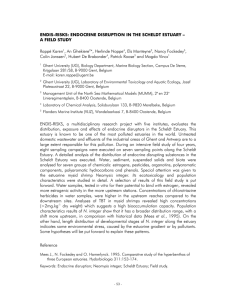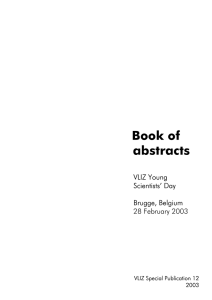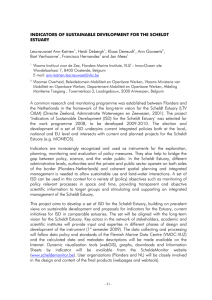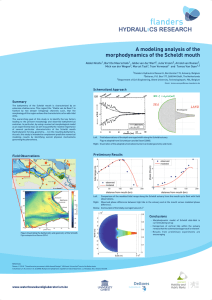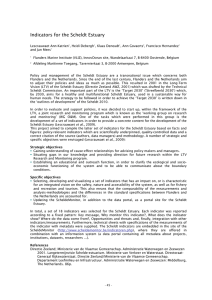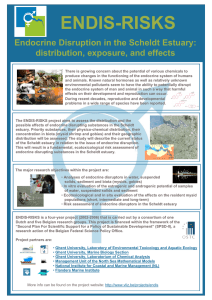Indicators for the Scheldt-estuary Societal response and cooperation
advertisement
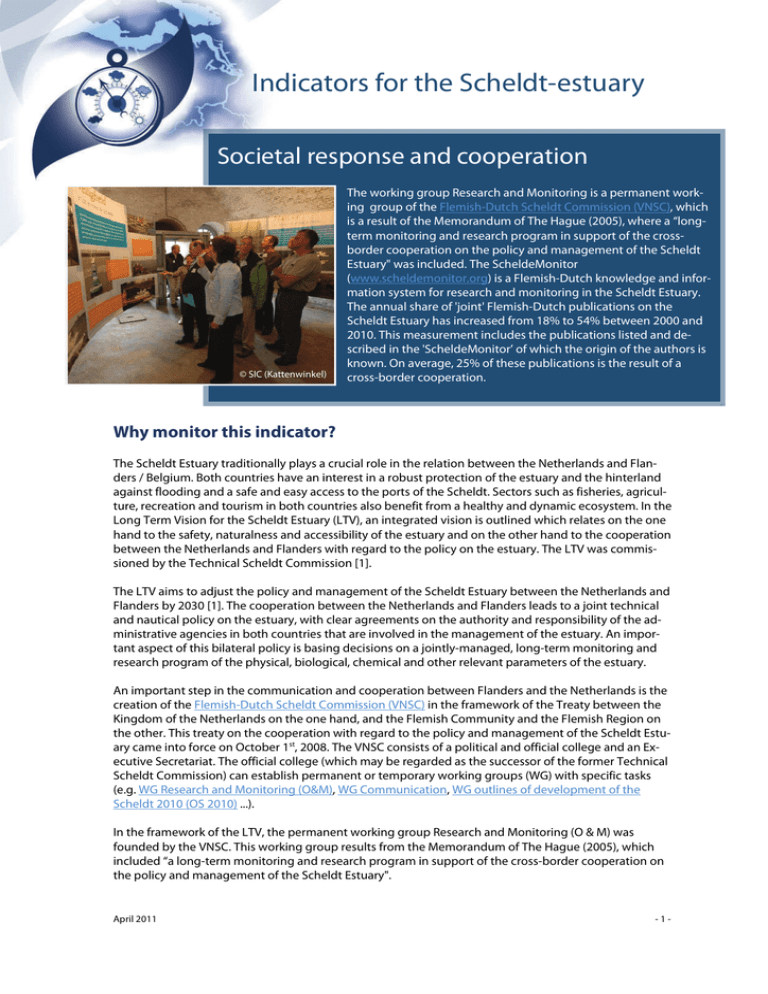
Indicators for the Scheldt-estuary Societal response and cooperation © SIC (Kattenwinkel) The working group Research and Monitoring is a permanent working group of the Flemish-Dutch Scheldt Commission (VNSC), which is a result of the Memorandum of The Hague (2005), where a “longterm monitoring and research program in support of the crossborder cooperation on the policy and management of the Scheldt Estuary" was included. The ScheldeMonitor (www.scheldemonitor.org) is a Flemish-Dutch knowledge and information system for research and monitoring in the Scheldt Estuary. The annual share of 'joint' Flemish-Dutch publications on the Scheldt Estuary has increased from 18% to 54% between 2000 and 2010. This measurement includes the publications listed and described in the 'ScheldeMonitor’ of which the origin of the authors is known. On average, 25% of these publications is the result of a cross-border cooperation. Why monitor this indicator? The Scheldt Estuary traditionally plays a crucial role in the relation between the Netherlands and Flanders / Belgium. Both countries have an interest in a robust protection of the estuary and the hinterland against flooding and a safe and easy access to the ports of the Scheldt. Sectors such as fisheries, agriculture, recreation and tourism in both countries also benefit from a healthy and dynamic ecosystem. In the Long Term Vision for the Scheldt Estuary (LTV), an integrated vision is outlined which relates on the one hand to the safety, naturalness and accessibility of the estuary and on the other hand to the cooperation between the Netherlands and Flanders with regard to the policy on the estuary. The LTV was commissioned by the Technical Scheldt Commission [1]. The LTV aims to adjust the policy and management of the Scheldt Estuary between the Netherlands and Flanders by 2030 [1]. The cooperation between the Netherlands and Flanders leads to a joint technical and nautical policy on the estuary, with clear agreements on the authority and responsibility of the administrative agencies in both countries that are involved in the management of the estuary. An important aspect of this bilateral policy is basing decisions on a jointly-managed, long-term monitoring and research program of the physical, biological, chemical and other relevant parameters of the estuary. An important step in the communication and cooperation between Flanders and the Netherlands is the creation of the Flemish-Dutch Scheldt Commission (VNSC) in the framework of the Treaty between the Kingdom of the Netherlands on the one hand, and the Flemish Community and the Flemish Region on the other. This treaty on the cooperation with regard to the policy and management of the Scheldt Estuary came into force on October 1st, 2008. The VNSC consists of a political and official college and an Executive Secretariat. The official college (which may be regarded as the successor of the former Technical Scheldt Commission) can establish permanent or temporary working groups (WG) with specific tasks (e.g. WG Research and Monitoring (O&M), WG Communication, WG outlines of development of the Scheldt 2010 (OS 2010) ...). In the framework of the LTV, the permanent working group Research and Monitoring (O & M) was founded by the VNSC. This working group results from the Memorandum of The Hague (2005), which included “a long-term monitoring and research program in support of the cross-border cooperation on the policy and management of the Scheldt Estuary". April 2011 -1- Indicators for the Scheldt estuary The ScheldeMonitor (www.scheldemonitor.org) is a key instrument within this joint monitoring and research program. It concerns a Flemish-Dutch knowledge and information system for research and monitoring in the Scheldt Estuary. It is developed and maintained by the Flanders Marine Institute (VLIZ). This portal provides access to 'information' about expertise, literature, projects and datasets. In 2010, the ScheldeMonitor evolved from an information system about the Scheldt to a portal with information, data and indicators on research and monitoring in the Scheldt Estuary. In this way, the ScheldeMonitor serves as a tool for the planned evaluations of the Scheldt Estuary. Other important administrative and consultative bodies in which cooperation and communication takes place between Flanders and the Netherlands with regard to the Scheldt Estuary are the Euregio Scheldemond, the International Scheldt Commission (ISC), the Common nautical Management (VTS-Scheldt), and the Rhine-Scheldt delta. What does the indicator show? This indicator reveals the share of Flemish (Belgian) - Dutch publications which are listed and described in the ScheldeMonitor module 'publications' (http://www.scheldemonitor.be/info.php). In this indicator all A1 and other peer-reviewed publications, project reports and study reports, doctoral and other papers, from 2000 onwards, are taken into account. The measurement gives the 'share of publications that was jointly released by Flemish / Belgian and Dutch authors in a given year, compared to the total number of publications published by Flemish / Belgian authors and / or Dutch authors in that particular year. 60 50 40 30 20 10 0 2000 2001 2002 2003 2004 2005 2006 2007 2008 2009 2010 Figure 1: The annual percentage (%) of joint "Flemish (Belgium)-Dutch 'publications which are described in the ScheldeMonitor module' publications'. The year numbers indicate the year of publication (not the year of inclusion in the system). The measurement was performed on the publications which are included and described in the ScheldeMonitor, and of which the origin of the authors is known. Source: ScheldeMonitor (Flanders Marine Institute, VLIZ). Between 2000 and 2010, the annual share of 'joint' publications increased from 18% in 2000 to 54% in 2010 (see Figure 1). This measurement only concerns the publications which are included and described in the ScheldeMonitor, and of which the origin of the authors is known. On average, 25% of these publications is the result of a cross-border cooperation in the period between 2000 and 2010. Given the fact that results of projects are in general published as a report and included in the ScheldeMonitor, it may be assumed that the current measurement also partly reflects the evolution of joint April 2011 -2- Indicators for the Scheldt estuary Flemish-Dutch projects (K. Deneudt, pers. comm.). Where do the data come from? The data are based on the ScheldeMonitor module 'publications' in the section 'Information' http:// www.scheldemonitor.be/info.php. This module not only contains formal publications in peer-reviewed and specialized journals, but also other publications, project and study reports, doctoral and other papers. A first limitation of this measurement concerns the extent to which these 'Scheldt Estuary-related' publications are listed and described in the ScheldeMonitor. The completeness was recently tested and is estimated at 75% (ScheldeMonitor team, pers. comm.). A second limitation relates to the fact that not for all authors, the origin or relationship with a Dutch or Flemish / Belgian research institute is disclosed or known. Hence, the selection cannot be performed on all described publications (e.g. when the information about the author is absent or incomplete in the 'person' module of the ScheldeMonitor). Due to these restrictions, the measurement is expressed as a relative number (% share) rather than an absolute number. In the future, the two limitations of this measurement will be updated, even retroactively, in order to provide more accurate information about the Flemish-Dutch cooperation with regard to the Scheldt Estuary. Opportunities and Threats The Scheldt Estuary is a very complex system that is continually subject to change as a result of both natural factors and human interventions [2]. Despite the numerous measurements in the Scheldt Estuary, some important gaps in knowledge still exist and further integration of the different measurement programs is required. This is particularly the case for the reporting with regard to the implementation of a number of laws and for the purpose of understanding of cause-effect relationships [2]. A joint monitoring program and cross-border cooperation when reviewing the monitoring results, guarantees an optimal management and policy. Hence, data fiches (technical data factsheets) have been developed in the framework of the MONEOS program, which describe the degree of correspondence between parameters in Flanders and The Netherlands. Thanks to this joint monitoring program, the traditional cooperation between Dutch and Flemish governments, authorities and knowledge and research groups is further extended. In addition to supporting a sustainable management of the Scheldt Estuary, it also creates opportunities for research institutes, laboratories and research offices to gain a leading position worldwide on estuarine research and management. How to refer to this fact sheet? Anon. (2010). Societal response and cooperation. Indicators for the Scheldt Estuary. Commissioned by the Maritime Access Division, project group EcoWaMorSe, Flemish-Dutch Scheldt Commission. VLIZ Information Sheets, 235. Flanders Marine Institute (VLIZ): Oostende, Belgium. 3 pp. Available online at http://www.scheldemonitor.org/indicatoren.php References [1] Directie Zeeland; Administratie Waterwegen en Zeewezen (2001). Langetermijnvisie Scheldeestuarium. Ministerie van Verkeer en Waterstaat. Directoraat-Generaal Rijkswaterstaat. Directie Zeeland/ Ministerie van de Vlaamse Gemeenschap. Departement Leefmilieu en Infrastructuur. Administratie Waterwegen en Zeewezen: Middelburg, The Netherlands. 86 pp. + toelichting 98 pp., details [2] Meire, P.; T. Maris (2008). MONEOS. Geïntegreerde monitoring van het Scheldeestuarium. Rapport ECOBE 08-R-113. Universiteit Antwerpen, Antwerpen. details April 2011 -3-
